Stories
White Lingerie
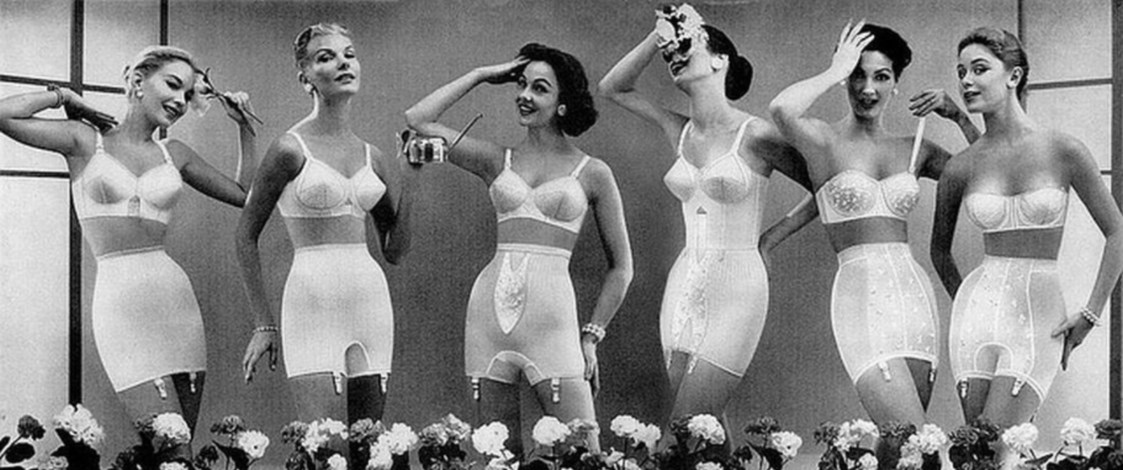
White intimate apparel has a long history. To the Victorians, pristine white undergarments represented respectability. To the Edwardians, white was the perfect colour to complement their love of ornamentation. To later generations, white lingerie symbolised innocence, luxury, sensuality or good taste.
In an article entitled 'A Chat on Lingerie', which appeared in the Wellington newspaper the Dominion in 1907, women were encouraged to employ their needlework skills and make their own underwear, using Irish or French linen, the "material de luxe that keeps beautifully white in the washing." The article went on to suggest lace as a suitable trim and to remind readers that "all undergarments, by the way, are threaded as profusely as ever with ribbons."
'Dainty White Lingerie' advertised by Kirkcaldie & Stains in the Dominion in 1909, included nightdresses, chemises, knee-length knickers, combinations and camisoles. "This Lingerie is delicate enough to become part of a bride’s trousseau and there’s many a bride who will be glad to see this advertisement. We have not had such a fine assortment of white underwear as this, and we have never been able to give better value."
Advertisements for a fine white cotton fabric called Tarantulle began turning up in newspapers and department store catalogues about 1915. It was promoted as being the ideal lingerie fabric and described variously as 'snowy white and pure', 'the snowiest, purest fabric for all-white lingerie' and 'invigoratingly fresh, white and wholesome always'.

Tarantulle lingerie fabric advertisement, Smith & Caughey’s autumn/winter catalogue, 1915.
In 1922, The Ladies Mirror reported the trend for snow white muslin and sheer, and lingerie cut on straighter lines to emphasise the new tubular fashion silhouette. They extolled the virtues of 'cunningly designed' cami-knickers, later known as teddies, which doubled as panties and slip.
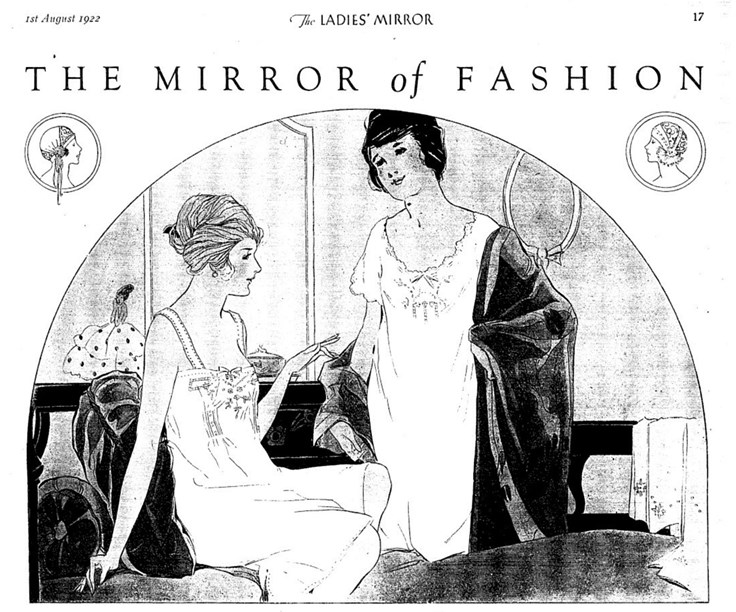
White chemise and nightgown with pintucks, hem-stitching, scalloped edges and embroidery. The Ladies Mirror, August 1922.
Corset Culture
From the late 1800s through to the 1950s, the corset was the most widely advertised underwear item. Unfortunately, the illustrations and later promotional photographs were black and white and mention was rarely made of the garment’s colour, leaving us to guess whether or not it was white. Women who were children in the 1940s remember their mothers’ salmon-pink corsets. This is consistent with the vogue for pink lingerie - all shades from peach to orchid - that dominated the mid-1920s and well beyond, ousting white as the fashionable favourite. In 1953, in what was possibly a New Zealand first for the company, a full-colour Berlei ad appeared on the back cover of The Mirror. It featured nylon bras and girdles, all of which were unequivocally white. Berlei’s Hollywood Maxwell bra, the original brassiere with continuous whirlpool stitching, also came in white as well as pink and black.
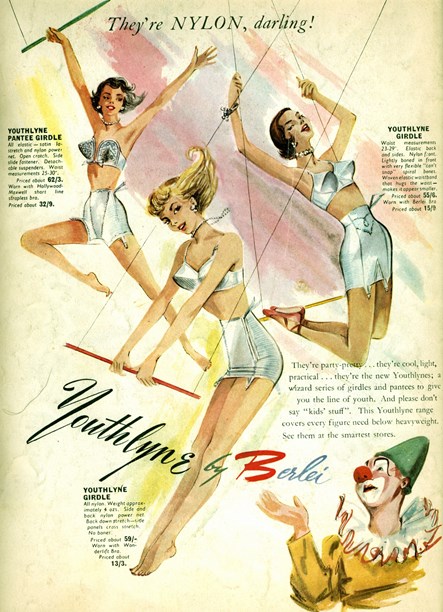
Youthlyne by Berlei advertisement, the Mirror, June 1953.
The Fifties and Sixties
The return of white lingerie in the 1950s coincided with the reappearance of ultra-feminine clothing. Teenagers at the time recall wearing form-fitting white slips, similar to the one worn by Elizabeth Taylor in Cat on a Hot Tin Roof (1958), under sheath dresses, and multi-layered white half-petticoats beneath dresses with full skirts. The latter, produced by the likes of Osti and Canterbury, were usually made from crackly, drip-dry paper nylon and starched by the wearer to provide extra volume.

1950s-style half-slips, lingerie fashion parade, Kirkcaldie & Stains, Wellington, February 1960. National Library EP/1960/0635.
White fell out of fashion again in the 1960s, one of the main arbiters of change being Bendon whose collections of colour-co-ordinated bras, briefs, slips and half-slips proved a great temptation, particularly to the younger generation. Compared to rich colours and black, white lacked the requisite cool.
White’s New Vibe
Not until the 1980s did white lingerie in New Zealand shed its decorous image, an image based on an assumed innocence that in all probability was always somewhat deceptive. Designs became more daring and were presented in ways that implied seduction. For a six-page white lingerie spread, showing local labels shot in New York, Fashion Quarterly posed scantily clad models alongside dinner-suited males wearing dark glasses. Trés chic, trés risqué. Fashion Quarterly and Cha Cha were two of the first local publications to celebrate white’s transformation from virginal to vamp.

Bendon satin bra and French knickers, Fashion Quarterly, winter 1989.
The sensuality of the white bodysuit was highlighted by photographer Regan Cameron in a 1987 lingerie shoot for Cha Cha that also featured French lace bustiers and silk satin pyjamas and boxer shorts. Tendril-thin straps, a high-cut leg-line and lace inserts were intrinsic to this bodysuit’s allure.
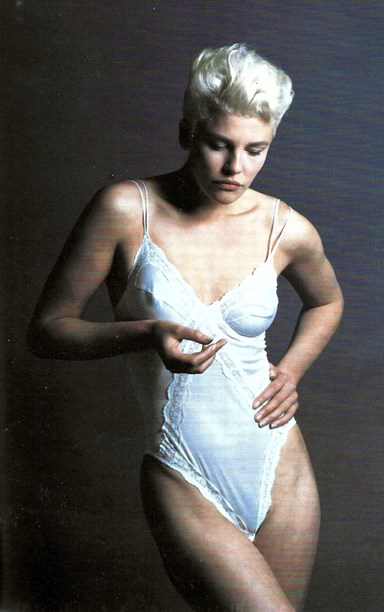
Lace-trimmed cotton bodysuit from Understatements. Cha Cha, July 1987. Photo by Regan Cameron.
In its new glamour guise, white lingerie also acquired a luxury image. Extravagance was a virtue in the 1980s. Paying $995 for an embroidered white silk satin camisole and matching French knickers from Kevin Berkahn would not have been an issue for the decade’s high-fliers. Unlike designer label outerwear, often worn to denote status, luxurious white lingerie was a pleasure to be enjoyed esoterically.
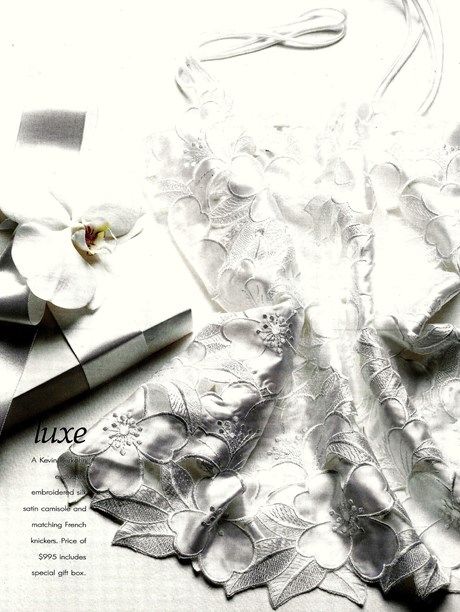
Kevin Berkahn embroidered silk satin camisole and French knickers with presentation box. Fashion Quarterly, late 1980s.
Although not confined to white, lingerie did eventually come out from under, reaching its peak popularity towards the end of the ‘90s. Long silky slips were worn as dresses or layered with dresses in see-through fabrics. Bras, bustiers and bodysuits were worn visibly under jackets, sheer dresses and tops.
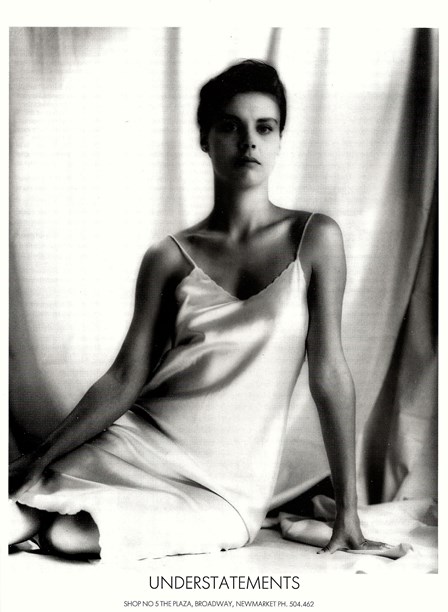
Advertisement for Understatements silk slip. More Fashion, winter 1988.
The Fitness Boom
As more and more women took up aerobics and other fitness-related activities, the demand arose for undergarments that provided comfort and freedom of movement. In its simplest form, women’s underwear began following the same lines as men’s. Exclusive of any trim, and designed in cotton with an element of stretch, this group included white briefs, boy shorts, singlets and tank tops, t-shirts and seamless bras. What Calvin Klein did in the US for singlets, cropped tops and unisex white briefs (with branded waistbands), Bendon did in Australasia for similar garments. Approached by the company in 1989 to promote their lingerie, Elle Macpherson became a byword for underwear of this type.
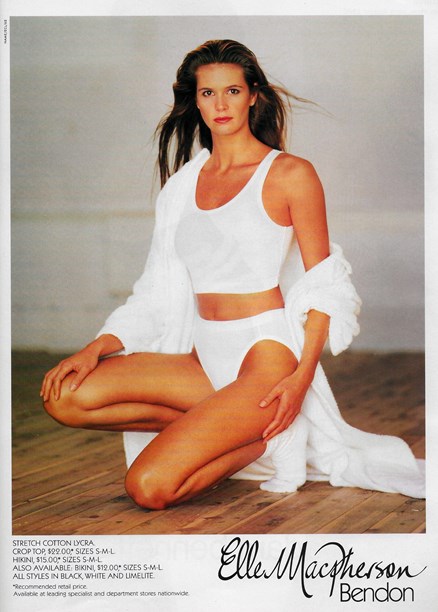
Elle Macpherson Bendon advertisement for stretch Lycra crop top and hikini. More Fashion, spring 1990.
In 1992, a spokeswoman for Bendon told Fashion Quarterly that traditionally the company used coloured lingerie displays to draw women into stores but it was usually white they ended up buying. Worldwide, at that time, 50 per cent of all lingerie sales were white, 20 per cent ivory and 10 per cent black.
Today, the fact that major manufacturers and boutique designer labels alike produce lingerie in a multitude of colours is an indication that tastes have changed. However, despite white now being one colour among many, it still has its adherents and continues to maintain a fashion presence.
Text by Cecilie Geary. Banner image of a Berlei publicity shot of white bras and girdles, 1960. Image © Berlei.
Published August 2020.